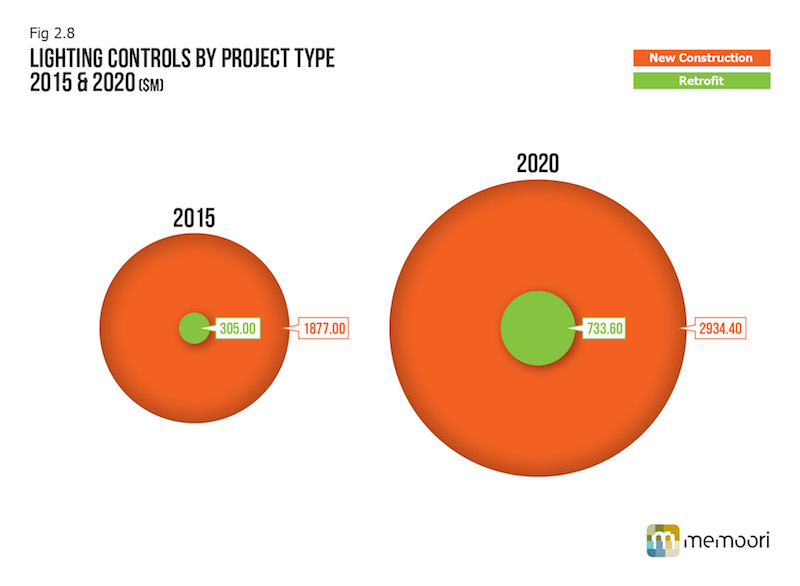The latest bus-based lighting control products not only offer a reduced operating cost through energy efficiency gains and maintenance costs but also the actual cost of controls hardware is changing through the elimination of certain system components. This is just one of the findings from our recent report into the global market for Lighting Controls – http://www.memoori.com/portfolio/smart-buildings-the-lighting-controls-business-2015-to-2020/
The change in all of these values alters the market dynamics by reducing the potential overall hardware revenues for the same volume while opening an opportunity to deliver higher value services to their customers. Which will in turn create more demand. This means that bus-based lighting controls can now deliver more for less.
 |
|
Memoori estimates lighting control market growth by project type. (Memoori/LEDinside) |
The rapid growth in the installation of LED lighting has opened up new opportunities for IP based controls and as the price of LED lighting has fallen significantly in the last five years demand for better and more functional control systems has also expanded.
There is the danger here that in the long term, LEDs and their control will be delivered on one chip and this would move the value away from the controls business to the light source just as Dali did some years ago.
However increase in demand for better lighting produced larger volumes of business and further compensation came from better and more lighting control sensors and improved software. History will no doubt repeat itself but this will require lighting controls companies to adjust to these changes by acquiring new skills.
There is still a perception in the building industry that lighting controls are complex and expensive to install. The wider acceptance of wireless technology, together with the reduction in required hardware, means that many of the added labour and materials costs associated with networked lighting controls can be eliminated. This should lead to an even greater acceptance of controls into new construction and refurbishment projects, which already make up some 90% of the market.
Much more importantly (so long as some of the conditions discussed in our report are met) there is an enormous latent market potential to open up the retrofit market for installing lighting controls into existing buildings. New construction projects account for, around, 2-3% of additional non-domestic floor space each year; which means that existing buildings has the potential offers up to 10 times more volume.
Our chart above from the report The Lighting Controls Business 2015 – 2020 shows the relative sizes of lighting control sales going into these two types of projects. We forecast that the growth in the retrofit market will almost be twice that of new construction business thanks to wireless communications becoming more robust.
Added functionality and the delivery of new benefits
The ability of properly designed and configured lighting control systems to deliver real energy and maintenance cost savings is well established. Even so it is not always possible to demonstrate a sufficiently attractive ROI to justify proceeding with the project. If lighting controls can provide additional functionality that can provide a business enterprise with a valuable sales tool or other commercial advantage then the investment would be more readily accepted.
Over the last five years or so, the lighting industry has been trying to develop a new lighting concept known as ‘dynamic ambience’; in this approach the illumination is altered in both intensity and color temperature to simulate the natural changes seen in daylight. However, establishing a specific worth to this concept has proved difficult to quantify even though there appears to be good evidence that staff are more alert and attentive and report better sleep patterns.
It is more likely that the new concept of ‘location based services’ might be better placed; it is intended to offer a service that might be more easily quantified. If users can show that there is direct correlation between sales and the use of this customer tracking technique then the investment will come.
Another development in the use of light as a communications medium – Li-Fi, a technique that modulates the light from an LED source at extremely high frequency in order to carry data in a similar manner to Wi-Fi.
The bandwidth available is attractive and there are advantages over broadcast wireless in terms of security. It would however require significant changes in lighting and controls technology, and Li-Fi has the distinct disadvantage of requiring line of sight.





 CN
TW
EN
CN
TW
EN






